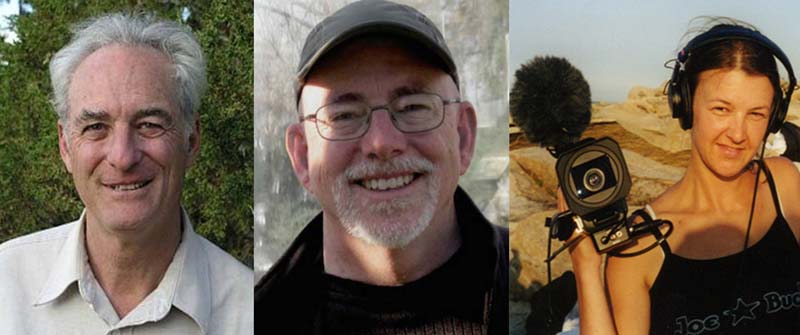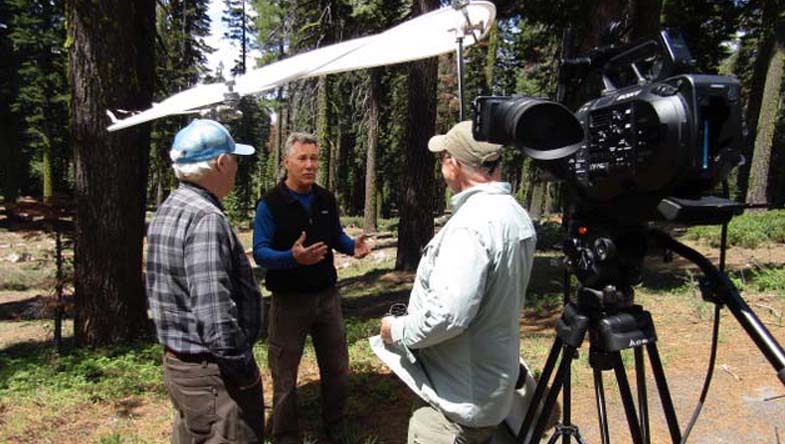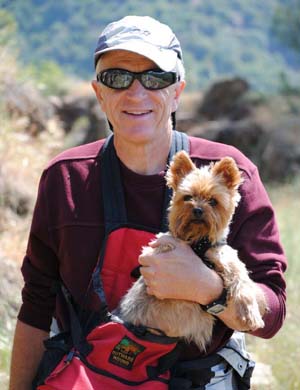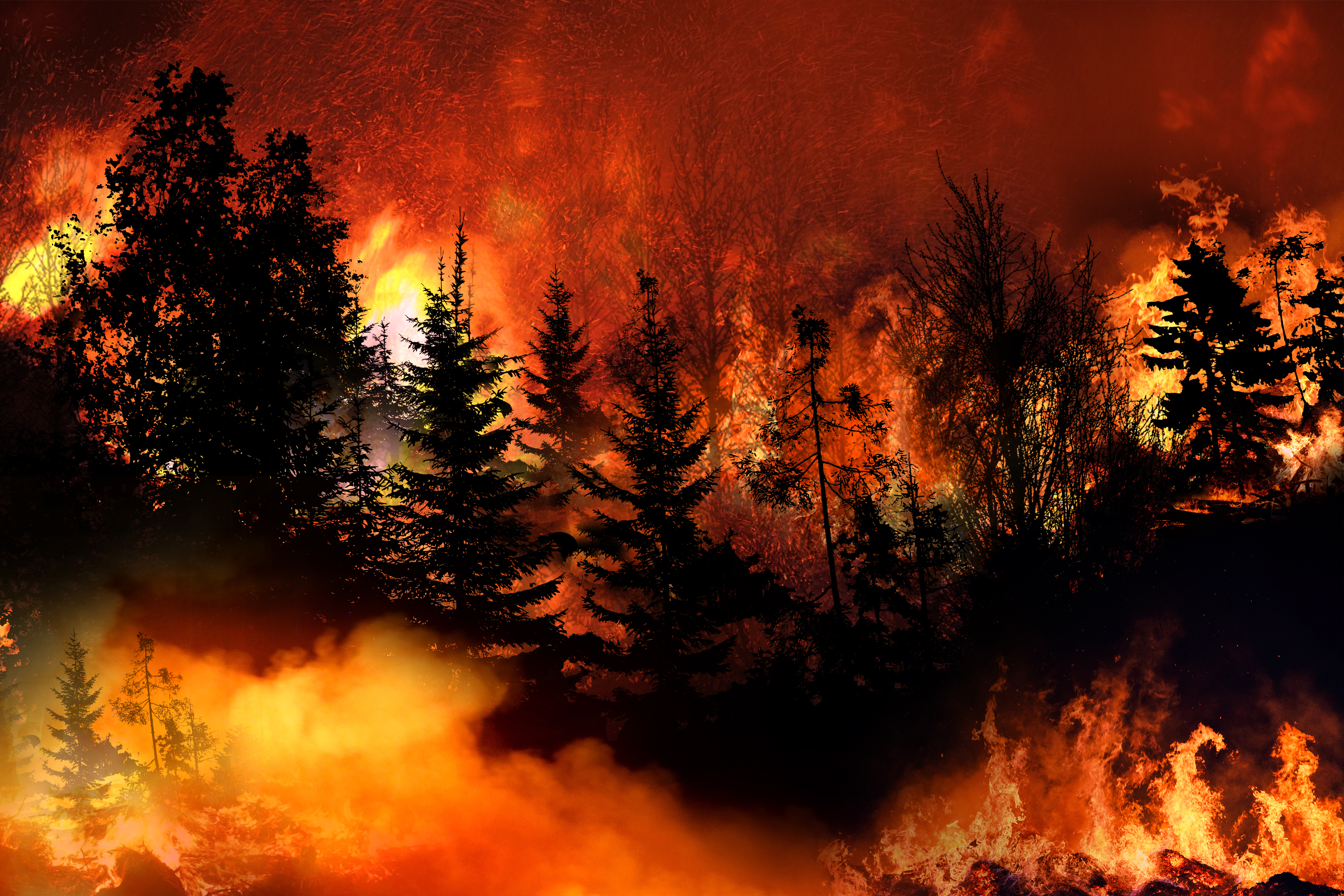[Note: As this story was being researched and written, the Camp Fire in Butte County, California, raged for 17 days, becoming the deadliest, most destructive wildfire in state history, with 85 confirmed deaths, 19,000 structures destroyed, including nearly 14,000 homes and 4,800 businesses, and 153,000 acres burned.]
__________
“The meaning of the flames depends on the story that grows out of the ashes.”
Pyne’s words fade in over a backdrop of dancing, crackling embers—miniature comets rushing chaotically about—in the trailer for a recently released documentary film, Wilder Than Wild: Fire, Forests, and the Future, from Full Frame Productions in San Francisco.
The words fade away and the camera jumps back to reveal a mature tree and some shrubbery on fire; a serious blaze, but nothing that suggests “inferno.” Then abruptly, with a whooshing boom like a cannon going off, the underbrush ignites.
The rippling, rushing flames are terrifying yet strangely beautiful. You can see the fire “inhaling” and intensifying as it sucks up the air, creating its own wind. Treetops burst into flame like wooden matches. The camera jumps back again. The entire forest is now ablaze, consuming itself. Roiling clouds of flame devour everything in their path. The speed with which a seemingly minor blaze has become a raging inferno is shocking.
It’s a phenomenon that’s happening with increasing and alarming frequency all over the American West.
__________
Filmmakers Stephen Most, Kevin White, and Gina Leibrecht (below)—Sierra Club members, all—began working on Wilder Than Wild in 2014, in the aftermath of the cataclysmic Rim Fire near Yosemite National Park. Sparked by an illegal campfire that got out of control in a remote canyon west of the park, the conflagration burned for over two months, penetrating Yosemite’s backcountry and compelling the evacuation of some 15,000 area residents before it was finally contained. By then it had entered the record books as the largest wildfire ever in the Sierra Nevada.

Stepen Most, Kevin White, and Gina Leibrecht
White’s family has a cabin in the Sierra, not far from where the Rim Fire torched more than a quarter-million acres. “Little did I realize that this would be a harbinger of wildfires to come that would have impacts far beyond the Sierra,” he says. “For me the Rim Fire raised important questions: What was different about this wildfire from the ones that occurred when I was a kid, and why is this happening now?”
What’s different is the size and intensity of today’s wildfires, brought about by a century of reflexive fire suppression on federally managed forest lands (think Smokey Bear) and exacerbated by climate change. Small trees and undergrowth that burned every few years under natural historic conditions have proliferated into dense thickets that are essentially tinder once a fire breaks out—ladder fuel, in firefighters’ parlance—resulting in hotter fires that quickly rage out of control.
At the same time, climate change is producing hotter and drier conditions that make trees more vulnerable to bark beetle infestations and allow fires to catch more readily and spread more rapidly. Some 130 million trees have died since 2010 in the Sierra Nevada due to conditions created or exacerbated by climate change.
In one scene in Wilder Than Wild, White and Forest Service ecologist Malcolm North visit Rim of the World, a popular overlook west of Yosemite that gave the Rim Fire its name. The landscape is charred and denuded of life as far as the eye can see.
“Forest fires didn’t used to leave behind this kind of total devastation,” North says. “The Rim Fire is a good example of where a lot of scientists and forest managers believe wildfires are headed, which is to these really large events that we call megafires. In the past, you’d lose groups of trees in small areas of 10 or 20 acres. What we have here is an area where there's probably not a single living tree for ten miles.”
He pauses. “We’re at a tipping point.”
A Sierra Club thread runs through Stephen Most’s body of work as a screenwriter, author, and playwright. He scripted the documentary, Oil on Ice, which the Sierra Club deployed in a public engagement campaign against drilling in the Arctic National Wildlife Refuge; he dramatized Sierra Club history in his play Forces of Nature that shows John Muir, Gifford Pinchot, and Theodore Roosevelt sparring over the fate of Hetch Hetchy Valley; and he worked with David Brower at the 1982 Fate of the Earth conference that Brower hosted, interviewing participants including Amory Lovins, Linus Pauling, and Lester Brown. “It was from Brown that I first learned about climate change,” he recalls.
Not long after the Rim Fire, Most was talking with a friend in the Forest Service who suggested that he and White make a film about it as an exemplary megafire. White agreed to direct and co-produce the project that would become Wilder Than Wild, and they tapped Leibrecht to be the editor. “This is the third film Kevin and I have worked on together, and Gina has edited all of them,” Most says. “The three of us work very well together.”
“We didn’t have a lot of money for this film,” says White, sitting in a screening room at Filmmakers Collaborative in San Francisco’s gritty South of Market neighborhood. “It was a labor of love, but we all agreed it’s a story that needed to be told.”
But telling the story in a compelling manner proved challenging. “Kevin and Steve took a traditional 'PBS style' approach at first, and to be honest the material was really dry,” Leibrecht says. “How do you talk about things like ladder fuels and collaborative stakeholder groups and be engaging?”
Finding the film to be “missing some heart,” Leibrecht pushed White to make the film more personal by narrating it himself, in the first person. “Kevin has a cabin up there, and he feels really passionate about the subject matter,” she says. “He’d be the emotional thread that holds the story together.” White was initially reluctant, but eventually he came to embrace the role of narrator.
“Facts don’t tell stories, people do,” Leibrecht says. “We have a habit in the environmental movement of talking about things like carbon sequestration and parts per million. We need to respect the science and the facts—something the current administration in Washington seems not to care much about—but we also need to turn those facts into something people can feel. My job is to figure out the best way to tell the story so it will sink in. You have to reach in and touch people’s hearts.”
__________
“We need to rethink how we’re living with wildfire,” says White. “Fire is a natural phenomenon that can have a positive effect on our forest ecosystems—unless it burns at high severity that exceeds historical norms for the forest. Unfortunately, that’s what we see happening more and more often due to a warming climate.”
Shorter, warmer winters have extended the fire season. “California’s largest wildfire ever until this year ignited last December,” Most says. “There’s no fire season anymore. Wildfires can happen any time of year.”
Record heat increased the impact of the recent five-year drought in California, and many trees have died from lack of water. Milder winters have doubled the breeding cycle of bark beetles, leading to greater conifer mortality. Nights have lower humidity, so fires don’t die down as they used to. Unprecedentedly powerful winds spread wildfires beyond their normal reach and bring them to blowtorch intensity.
Megafires and rampant deforestation are actually threatening to transform Earth’s forests from carbon sinks into net carbon emitters. The monster blazes send vast quantities of smoke into the atmosphere, accelerating climate change, which leads to more extreme weather, which stokes megafires, and the vicious cycle is perpetuated.
“The concept of a vicious cycle between megafires and climate change may be the most important thing I learned during the making of Wilder Than Wild,” Most says. “I’d never heard of pyrocumulous clouds or fire tornados before I started working on this project. I didn’t know that smoke from megafires can travel such huge distances and contribute so significantly to climate disruption.”
To use the latest megafire as an example, greenhouse gas emissions from the Camp Fire were roughly the same as what all of California’s cars, trucks, and motorcycles emit in a week. Last year, greenhouse gases released by California fires accounted for nearly 10 percent of the total generated by human activity statewide.
Most believes we should take a page from the playbook of the indigenous North Americans who lived here for millennia prior to the arrival of Europeans. “Western forests evolved with fire,” he says. “Prescribed cultural fire was part of the ecological knowledge of indigenous people. It should be brought back, both to restore forest health and to protect communities at the wildland/urban interface, where human development meets unoccupied, undeveloped land. We need to reconsider where our homes are built, how they’re built, and whether we should even be building in fire-prone areas. We need to reconsider our relationship with fire.”
Adds White: “Not only forest ecologists, but most firefighters believe it’s of the utmost importance to introduce prescribed burns as a way of mitigating megafires.”
__________
Former firefighter John Buckley is one such person. A volunteer with the Sierra Club’s Tuolumne Group, Buckley is executive director of the Central Sierra Environmental Resource Center and a founding member of Yosemite Stanislaus Solutions (YSS), a collaborative group comprised of local stakeholders with sometimes widely divergent interests. A partial list includes the timber industry, forestry groups, mining and energy concerns, environmental and civic groups, the construction industry, farming interests, hunters, anglers, hikers, dirtbikers, bicyclists, Native American tribes, and “liaison groups” including the Forest Service, BLM, California Fish & Wildlife, and Yosemite National Park.

John Buckley (center) being interviewed for Wilder Than Wild
YSS’s raison d'être is to take the agendas of these groups and hammer them into strategies for maintaining healthy forests that are more resistant to wildfires, and to develop recovery and restoration plans for areas that have burned.
“Overall, the YSS process has gone very smoothly,” Buckley says. “We have an extremely skilled facilitator who insists on respect and acceptance of other people’s views. When Wilder Than Wild was being filmed, I was co-chair along with a timber industry representative, and we're both still part of the YSS leadership team.”
Also representing the Sierra Club on YSS is Kevin Rice (below), a retired professor of forest ecology at U.C. Davis. “Given the very diverse views of the participants in this group, the likelihood of useful discussion would be next to nil if this was just a forum for people to express their personal beliefs,” he says. “But it was agreed from the get-go that we’d adhere to a science-based approach, and that helps us formulate very effective grant proposals. I'm a strong believer in managing lands using the best science available, and that's something I very much appreciate about YSS.”
 Rice says the consensus structure of the group is unusual but refreshing in that it helps avoid a tyranny of the majority. "Organizations with a strong environmental orientation, like the Sierra Club and Audubon, are in the minority, but the consensus structure gives us strong leverage. If an action is proposed that we're not comfortable with and might veto, there's a strong incentive to compromise."
Rice says the consensus structure of the group is unusual but refreshing in that it helps avoid a tyranny of the majority. "Organizations with a strong environmental orientation, like the Sierra Club and Audubon, are in the minority, but the consensus structure gives us strong leverage. If an action is proposed that we're not comfortable with and might veto, there's a strong incentive to compromise."
YSS favors ramping up prescribed burning and forest thinning on federal lands. The national Sierra Club and the Mother Lode Chapter, of which the Tuolumne Group is a part, oppose any commercial logging on public lands, so Rice and Buckley focus on prescribed burning and better oversight of thinning operations to ensure that no clear-cutting takes place.
“The Sierra Club is sometimes accused of being obstructionist and putting up barriers that prevent forest projects from being approved,” says Buckley. “But showing up and participating and listening respectfully to opposing views greatly reduces the potential for rancor from industry groups or special interests toward the conservation community.”
“It’s great to see the local Sierra Club participating in YSS,” says Kevin White (not to be confused with Kevin Rice). “It’s an example of what keeps the Sierra Club truly grassroots. I think the Club is in a position to take a leadership role in shaping how we think about wildfire, now and in the future.”
__________
Maddeningly, the torrential rains Californians were looking to the sky and praying for walloped the state 10 days too late for the 27,000 residents of Paradise, which has been all but erased from the face of the earth. “We never thought wildfires would be so topical in 2018 when we started working on Wilder Than Wild four years ago,” White says.
“The timing couldn’t have been more potent,” says Leibrecht. “We were about to lock picture when the October 2017 Northern California wildfires broke out. Thousands of homes burned in Santa Rosa, a city of nearly 200,000 people. That brought the story out of the forest and into the urban-wildland interface.”
Most hopes climate-change deniers who see the Wilder Than Wild will realize global warming isn’t an abstract matter or a political issue. White wants the film to galvanize communities and jump-start “meaningful conversation” about climate change.
“At root, this film is about caring about the planet,” says Leibrecht. “The lessons in the film are lessons we need to learn no matter where we live. I hope people come to understand that we need to have a relationship with fire. Fire has always been the bad guy, but it’s part of nature. If we don’t make friends with fire, fire will eat us for lunch.”
Find upcoming screenings of Wilder Than Wild—or host your own screening. Community screening kits are available at wilderthanwildfilm.org.
